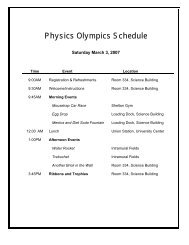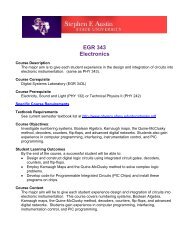Lab 11 - Physics & Astronomy
Lab 11 - Physics & Astronomy
Lab 11 - Physics & Astronomy
- No tags were found...
Create successful ePaper yourself
Turn your PDF publications into a flip-book with our unique Google optimized e-Paper software.
<strong>Astronomy</strong> 105 <strong>Lab</strong>oratoryLAB <strong>11</strong>
AST 105Review for <strong>Lab</strong> Exam
Ast 105 <strong>Lab</strong> ExamTuesday, April 15 at 6:30 pm in the Kennedy AuditoriumDon’t be late!!Items to bring…- One scantron (882-E)- two pencilsDo not bring…- cell phones or anything else for that matter(if your cell phone rings or is seen by a TA you will receive a zero)
Study!• About 3-5 questions from each lab exercise• Review Main concepts covered Procedures and measurements Questions and calculations Bring a scantron: 882-E Review material – Power point slides online
THE MOON
N.P.SynchronousRotationN.P.N.P.N.P.Does the Moon rotate on it’s axis?What is the Moon’s hidden side?N.P.
N.P.Phase: 1 st quarterRise Time:Set Time:NoonMidnightTransit: SunsetSunsetMidnightN.P.NoonSunrise
EastNorthSummerSolsticeEclipticSun’s PathVernalEquinoxAutumnalEquinoxCelestial EquatorSouth
EastMarch 7 @ 8:00 p.mNorthZenith32° XWest HorizonMeridianSouth
March 7 @ 8:00 p.mWest Horizonnot visibleEast HorizonEastMeridianWest
Sky Familiarization• A Few More Things to Remember Any vertical line on your SC-1 (north-south) is ameridian. Approximately one half of the stars on the SC-1are visible at any given time (12 hours of RA). Meridian moves eastward 4 minutes each day(Earth’s revolution) Meridian moves eastward 1 hour of RA for everyhour of time (Earth’s rotation)
SCIENTIFICMEASUREMENTS
Scientific Experiments / Observations• Physical quantities can never bemeasured with absolute precision
How Many Significant Figures0.089 21.089 412000 212001 5
Scientific Notation3.502 x 10 6decimal number (1-9)10 raised to aninteger powerNumber Significant Figures Scientific Notation9004 4 9.004 x 10 30.000007 1 7 x 10 -643 2 4.3 x 10 17,805,000,000 4 7.805 x 10 90.0408 3 4.08 x 10 -28.4 2 8.4 x 10 0
To multiply two numbers in scientific notation multiply thedecimal parts of the numbers and add the exponentsalgebraically.(4.0 x 10 4 )(2.0 x 10 3 ) =(4.0 x 2.0)(10 4 x 10 3 ) =(8.0) x (10 4+3 ) =8.0 x 10 7(6.0 x 10 2 )(2.0 x 10 5 ) = 12.0 x 10 7 = 1.2 x 10 8
Units• Provides numerical context for a measurement• Unit conversionEx. Convert 500 kilometers into centimeters1000 m = 1 km 1 m = 100 cm1000 m1 km = 1 and 100 cm1 m = 1500 km ×1000 m1 km×100 cm1 m = 5 × 107 cm
MERCURY’S ORBIT
Verifying Kepler’s 1stMercury’s OrbitMajor AxisSUNFFEqual Time Intervals010 20 30 40 50 60 70 80 90 100610 km<strong>11</strong>0 1200.00.10.20.30.40.50.60.7AU 0.8
Verifying Kepler’s 2 ndEqual area in equal time.Mercury’s OrbitMajor AxisSUN010 20 30 40 50 60 70 80 90 100610 km<strong>11</strong>0 1200.00.10.20.30.40.50.60.7AU 0.8
P24πG2Kepler’s 3 rd )P 2 =ka 3Finding the Sun’smass.am 3Mk42G( m Mmm Msun24GaP32mm MsunMsunM sun24GaP32
EMISSION SPECTRA
Formation of Emission andDark Line Spectra
THE EARTH’S ORBITAL VELOCITY
The Doppler EffectVelocity = 012345IncreasingVelocityvr ocIncreasingVelocity
V AArcturusV B? ?vAc Δλλ0From measuredDoppler Shift1.Orbital velocity of Earth2.Radial velocity of Arcturus3.Radius of the Earth’s Orbit o
THE HR DIAGRAM
Apparent Brightness of Stars• Stellar Luminosity -- Total amount of lightenergy emitted each second Surface Area Temperature• Distance from the Earth
Magnitude• Stellar Brightness Apparent Magnitude (m v ) - Brightness from Earth Absolute Magnitude (M v ) - Brightness from 10 pcAbsolute magnitude depends only on a star’s luminosity (the star’s wattage)MagnitudeDifferenceBrightness Ratio(Brightness Difference)1 (2.512) 1 2.52 (2.512) 2 6.33 (2.512) 3 15.94 (2.512) 4 405 (2.512) 5 1006 (2.512) 6 251
BSpectral Classification
Absolute MagnitudeHR Diagram-10-50The SunM=+5 G2+5+10+15O B A F G K MTemperature
LuminosityClassIa & IbIIIIIIVVSizeSupergiantBright GiantGiantSub-giantDwarfThe Sun’s Spectral and Luminosity Class: G2 V
Spectral LuminosityStar m vM vType ClassAldebaran +0.9 -0.2 K5 IIIAlpha Centauri A 0.0 +4.4 G2 VAntares +0.9 -4.5 M1 ICanopus -0.7 -3.1 F0 IIFomalhaut +1.2 +2.0 A3 VRegulus +1.4 -0.6 B7 VSirius -1.4 +1.4 A1 VSpica +0.9 -3.6 B1 VWhich star appears faintest in our sky?Which star has the greatest luminosity?RegulusWhich star has the highest surface temperature?Which star is a red giant?AldebaranAntaresWhich main-sequence star has the longest lifetime?SpicaAlpha Centauri
STELLAR PARALLAX
Stellar Parallax• Motion of Earth cause parallax shifts• Used to find distance to stars out to a few hundred light-years• Parallax is ½ of measured shift• More distant stars have a smaller parallax… a star with ½ the parallaxof another star is 2x farther away• d = 1 / p “p” is in arc seconds and “d” is in parsecsEarth1 AU1 arcsec1 pc 2 pc 3 pcSun1/2 arcsec1/3 arcsecStar 1 Star 2 Star 3arcsecarcsec1 parsec 2 parsec 3 parsec5 light-years 10 light-yearsA star with a parallax of 1 arcsecond isat a distance of 1 parsec (1 pc = 3.26 ly)More distant stars havesmaller parallaxes.A star’s distance in parsecs is given by= 1where d is in parsecs and p is in arcseconds
THE PLEIADES
Stars in a Cluster•Common Properties•Distance•Age•Different Properties•Spectral Types (temperature)• Luminosity Class (size)
Star ClusterHR Diagram10 pcMain-sequenceDistance Modulus = m - MThe difference between the absolute magnitude andthe apparent magnitude can d >10 be pc used to find thedistance to a star cluster.If m-M > 0 then the distance to the cluster is > 10 pc.If m-M = 0 then the distance to the cluster is = 10 pc.If m-M < 0 then the distance to the cluster is < 10 pc.d
Cluster A: Distance 50 lyCluster B: Distance ?The apparent brightness of thestars in Cluster B are 4 timesfainter than the stars in Cluster A.What is the distance to Cluster B?Inverse-Square Law: √4 = 2Cluster B is 2 times farther or 100 ly.
AGES AND DISTANCES TO CLUSTERS
• Interstellar Dust Reddens Light (makes stars appear cooler) Dims Light (makes stars appear further away)
Pleiades - Open ClusterDistance - 380 ly Age - 60 million yearsB6 stars -- 60 million yrs.MS lifetimeage of cluster = lifetime of starsat main-sequence turnoff point
HUBBLE’S LAB
Recessional Velocity is Proportional to Distance10 Mpc 20 Mpc 30 Mpc 40 MpcMilkyWay A B C1400700V = 0 70014002100 2800km/sec40 Mpc30 Mpc20 Mpc 10 Mpc Alien’sGalaxyMilkyWay A B C10 Mpc 20 Mpc2800 2100 1400700V = 07001400km/secThe Universe is Expanding!!
Finding a Galaxy’s DistanceHubble’s LawHubble Diagramv = H o dd = v / H oTo Find Distance:Measure recessional velocity (red shift)132 Mpc
Sample Galaxies• Distance images• Recessional Velocity spectra
Hubble DiagramHubble Diagramv = H o x dxxxriseProcedure- plot data- draw best fit line- find slope (H o )xxrunslope = rise/run
ROTATION OF SATURN
<strong>Lab</strong>oratory Spectrum<strong>Lab</strong>oratory - No Radial motionSpectral Lines MatchEarthDistant StarRadial Velocity = 0BlueshiftRadial Velocity -RedshiftRadial Velocity + o
The Doppler Effect: Measuring the Radial Velocity of a Star<strong>Lab</strong>oratory Spectrum<strong>Lab</strong>oratory - No Radial motionSpectral Lines MatchEarthDistant StarvRadial Velocity = 0rΔλ λocBlueshiftRadial Velocity -Radial Velocity -RedshiftRadial Velocity +Radial Velocity + o
Important: Do not write or mark on theSaturn Handout
Spectroscope SlitLight from hereshows the largestRed ShiftLight from hereshows the largestBlue ShiftNo Doppler Shift fromthis Light
VAΔλA 2λ0VcSaturnBVΔλB 2λ0VcVcΔλλ 0Doppler o A BV c Δλ4λ 0kmsec
Top oReferenceLineBottom (mm) = Top Distance – Bottom DistanceV c Δλ4λ 0kmsecc = 300,000 km/s o = 6200 Å
Finding the Rotation Period of SaturnVPeriod = Distance / VelocityRDistance = Equatorial Circumference = 2RPeriod (P) – Rotation PeriodSaturnP = 2 R / VP2VR
THE END
1 parsec (pc) = 3.26 lyC4.2Apparent MagnitudeAbsolute Magnitude5.06.00.03.3B2.0D1.32.0ASun-26.55 pc 10 pc 15 pc
Verifying Kepler’s 2 ndEqual area in equal time.A 2A 1
Verifying Kepler’s 1stP 2L 3L 4P 1L 1L 2Centerperiluna
The AST105 <strong>Lab</strong> Exam is the week ofNovember 29 (Week after Thanksgiving).1. True2. False15


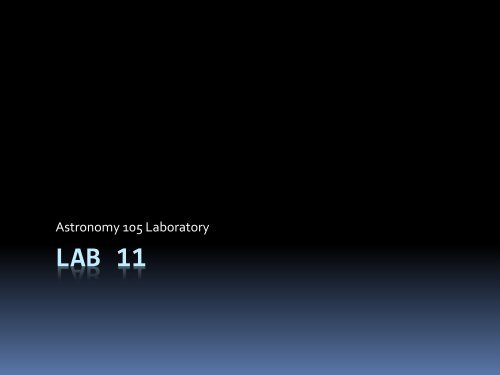

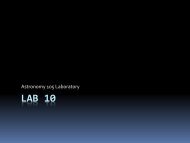
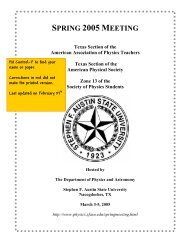
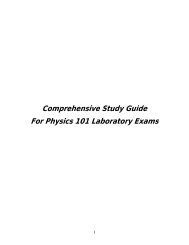

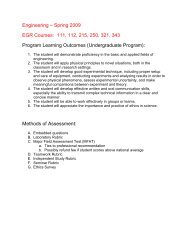
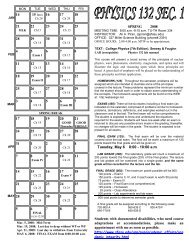
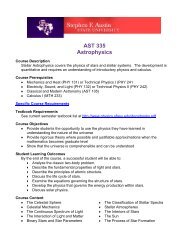

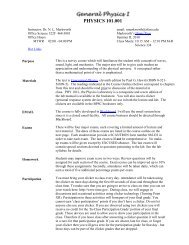
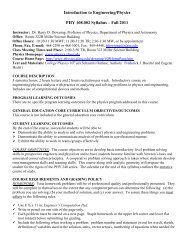
![[pdf] physics 110 fundamentals of electronics](https://img.yumpu.com/29312006/1/190x245/pdf-physics-110-fundamentals-of-electronics.jpg?quality=85)
